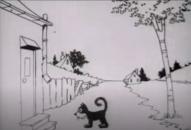AustLit
Latest Issues
AbstractHistoryArchive Description
"Pussyville has its "Follies" as well as Broadway. Its fads, foibles, and frivolities are as brilliant and as mischievous as the Great White Way brand. And the feline version has a plot, categorically speaking." (Source: Film opening)
Notes
-
Feline Follies is the first animated silent film starring Felix the Cat. The character Felix began as "Master Tom".
-
The creative origins and ownership of "Felix the Cat" are fraught, and so only the first 'Felix the Cat' film by Pat Sullivan is included in AustLit.
Publication Details of Only Known VersionEarliest 2 Known Versions of
Works about this Work
-
Felix the Catalyst : An Antipodean Who Animated Modernism
2020
single work
criticism
— Appears in: JASAL , vol. 20 no. 2 2020;'Despite acknowledgement that cultural exchange is an active two-way process, there remains metropolitan condescension towards the role played by the less powerful peripheral partner in this transaction. It is still the centre that determines whether to recognize, to accept, and to appropriate the visual imagery of its former colonies and, finally, whether or not to absorb it into the High Art canon. Yet, in peripheral societies that lacked both public art institutions and private patronage, the imperium’s cultural traditions could not be reliably promulgated by High Art alone. Instead, this cultural colonisation was achieved by means of the less esteemed imagery that commonly goes by the misnomer ‘popular’ visual culture.
'If, in its reductive simplification of great art, popular visual culture is considered well suited to a mere colony, is it not ironic that it has been reabsorbed surreptitiously from colony back to metropole? Because of its lowly status, its ubiquity, its anonymity, and the speed of its distribution, popular visual culture has infiltrated the metropolitan mainstream as if it were a clandestine colonial counter-attack—as seen in the example of Felix the Cat, alter-ego of the Sydney-born cartoonist Pat Sullivan, whose Australian larrikinism has been recast as the exemplar of ‘modern trickery’, and whose self-referential, metamorphic, transgressive and updated carnivalesque behaviour has influenced modern culture, world-wide. Sullivan/Felix is just one of many unrecognized expatriate Antipodeans who, as popular artists and performers working ‘undercover’, have successfully challenged—even changed—the hierarchical tenets of traditional western culture.' (Publication abstract)
-
Reclaiming Felix the Cat
2005
single work
essay
— Appears in: Upfront , March vol. 17 no. 1 2005; (p. 15) -
'Felix' the Cat : A World Famous Cartoon Creation by an Australian
1926
single work
biography
— Appears in: The Home , 1 January vol. 7 no. 1 1926; (p. 74)
-
Reclaiming Felix the Cat
2005
single work
essay
— Appears in: Upfront , March vol. 17 no. 1 2005; (p. 15) -
'Felix' the Cat : A World Famous Cartoon Creation by an Australian
1926
single work
biography
— Appears in: The Home , 1 January vol. 7 no. 1 1926; (p. 74) -
Felix the Catalyst : An Antipodean Who Animated Modernism
2020
single work
criticism
— Appears in: JASAL , vol. 20 no. 2 2020;'Despite acknowledgement that cultural exchange is an active two-way process, there remains metropolitan condescension towards the role played by the less powerful peripheral partner in this transaction. It is still the centre that determines whether to recognize, to accept, and to appropriate the visual imagery of its former colonies and, finally, whether or not to absorb it into the High Art canon. Yet, in peripheral societies that lacked both public art institutions and private patronage, the imperium’s cultural traditions could not be reliably promulgated by High Art alone. Instead, this cultural colonisation was achieved by means of the less esteemed imagery that commonly goes by the misnomer ‘popular’ visual culture.
'If, in its reductive simplification of great art, popular visual culture is considered well suited to a mere colony, is it not ironic that it has been reabsorbed surreptitiously from colony back to metropole? Because of its lowly status, its ubiquity, its anonymity, and the speed of its distribution, popular visual culture has infiltrated the metropolitan mainstream as if it were a clandestine colonial counter-attack—as seen in the example of Felix the Cat, alter-ego of the Sydney-born cartoonist Pat Sullivan, whose Australian larrikinism has been recast as the exemplar of ‘modern trickery’, and whose self-referential, metamorphic, transgressive and updated carnivalesque behaviour has influenced modern culture, world-wide. Sullivan/Felix is just one of many unrecognized expatriate Antipodeans who, as popular artists and performers working ‘undercover’, have successfully challenged—even changed—the hierarchical tenets of traditional western culture.' (Publication abstract)





